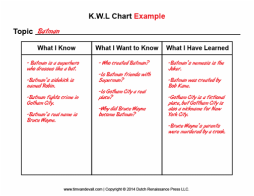What is a KWL Chart?
A KWL chart is a comprehension strategy for all students. There are three columns in a KWL chart. In the first column is the K, which stands for what the students already know about the topic. The W is in the second column and stands for what the students want to know about the topic. Finally, the L (in the third column) stands for what the students have learned. This is helpful for all students in all content areas because it activates their prior knowledge and gets them thinking about a specific topic. The KWL chart also allows the students to reflect on what they have learned. They may want to answer the questions they wrote in the "what do you want to know" column. This strategy helps students comprehend what they have learned by having them think about the topic and then reflecting on what they learned. According to Wayne Wright (2015), the KWL chart is helpful for teachers of ELL students, because it gives them a way to find out what vocabulary knowledge the students already have on the topic. The book gives an example of the topic being transportation. In the "K" column, the student writes down car, bus, airplane, truck, street, very, tanker, etc... This shows the teachers which words the student knows and can understand. This will give the teacher background knowledge of the students and help when planning the lesson.
Visual Representations
Content Areas
Reading- This strategy is mainly used in a reading lesson. This will help build students comprehension as they read by first activating the students prior knowledge, and then having them finish by writing what they have learned. Some students may struggle with writing down what they know, want to know, and have learned. It is okay to accommodate and have the student tell you or record their answer.
Math- This strategy could be adapted in a math lesson by giving the students a unit and having them write down what they know about these types of problems. Then, they can write down any questions, confusion, or misconceptions they may have about the problem. Finally, the students may write down what they have learned by maybe coming up with their own problem and solving it, or just solving a problem provided by the teacher. In this column the students should be able to justify how they got their answer by writing a written explanation.
History- This strategy could be adapted in a history lesson by assigning the students a chapter in their history book. For example, the teacher may assign the students a chapter on a specific time period. The students will then write down what they know about that time period, and what happened during that time. Then, the students will write down questions they may have about that time period, and finish by writing down what they have learned. This will help students better understand what they are reading.
Science- This strategy could be adapted in a science lesson by assigning the students a chapter or by giving them an article to read. The students will then activate their prior knowledge and start thinking of what they know about the specific topic. Now that they have been thinking about what they already know, they may have questions or concerns about the topic and may want to write them down in the "W" column. Finally, after they have read about the topic, they are going to deepen their understanding by reflecting on what they have read, and write down what they learned.
Math- This strategy could be adapted in a math lesson by giving the students a unit and having them write down what they know about these types of problems. Then, they can write down any questions, confusion, or misconceptions they may have about the problem. Finally, the students may write down what they have learned by maybe coming up with their own problem and solving it, or just solving a problem provided by the teacher. In this column the students should be able to justify how they got their answer by writing a written explanation.
History- This strategy could be adapted in a history lesson by assigning the students a chapter in their history book. For example, the teacher may assign the students a chapter on a specific time period. The students will then write down what they know about that time period, and what happened during that time. Then, the students will write down questions they may have about that time period, and finish by writing down what they have learned. This will help students better understand what they are reading.
Science- This strategy could be adapted in a science lesson by assigning the students a chapter or by giving them an article to read. The students will then activate their prior knowledge and start thinking of what they know about the specific topic. Now that they have been thinking about what they already know, they may have questions or concerns about the topic and may want to write them down in the "W" column. Finally, after they have read about the topic, they are going to deepen their understanding by reflecting on what they have read, and write down what they learned.
References
(2014). KWL Chart Template. Tims Printables. Retrieved From http://www.timvandevall.com/kwl-chart-template/
Gardner, B. (n.d.). Teachers Pay Teachers: KWL chart. Retrieved From
https://www.teacherspayteachers.com/Product/KWL-Chart-595724
mjoiep. (2009). KWL [Video File]. Retrieved From https://www.youtube.com/watch?v=iWL1BcHutCI
Wright, W. (2015). Foundations for teaching English language learners: research, theory, policy, and practice. Philadelphia, PA: Caslon, Inc.
Gardner, B. (n.d.). Teachers Pay Teachers: KWL chart. Retrieved From
https://www.teacherspayteachers.com/Product/KWL-Chart-595724
mjoiep. (2009). KWL [Video File]. Retrieved From https://www.youtube.com/watch?v=iWL1BcHutCI
Wright, W. (2015). Foundations for teaching English language learners: research, theory, policy, and practice. Philadelphia, PA: Caslon, Inc.


